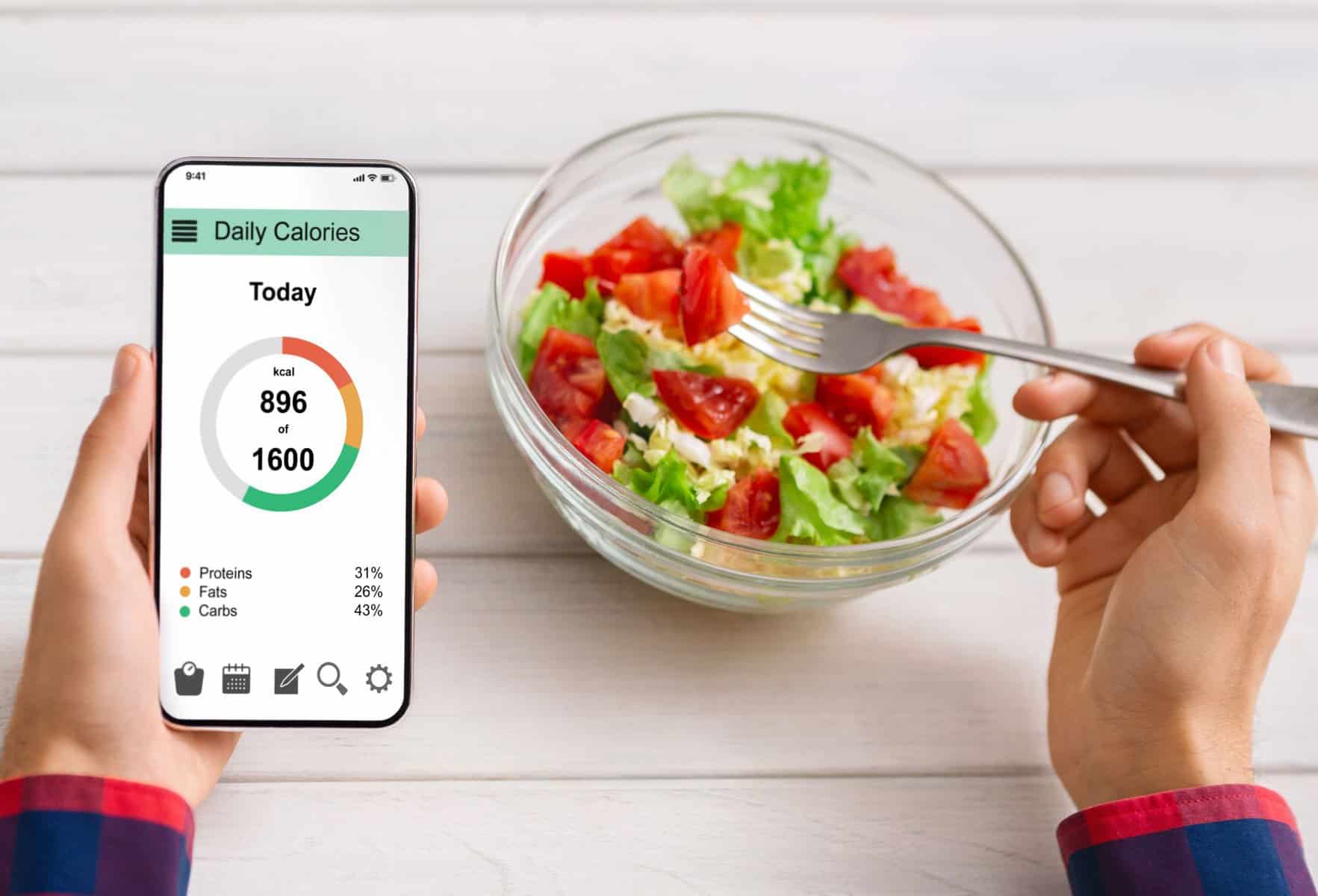
Picture this. You’ve decided to improve your diet, and you’re feeling motivated to make some positive changes. You decide to keep track of what you’re eating and download an app to help you out. Great work! There is evidence to show that building awareness can help with making positive changes (1).
The app you’ve downloaded asks you to tediously find everything you’re eating in a database and log it all down to the gram. And the main piece of information it gives you? Calories. Suddenly you’re finding that you’re anxious about the foods you’re eating, you feel terrible if you go over the calorie allowance that the app set for you and measuring and entering absolutely every food is time consuming and stressful. Inevitably, you end up giving up the calorie tracking, and the goal of a healthy diet is shelved.
Calorie tracking seems to be all the rage right now. But if it’s so great, why is it so hard to stick to?
What is a calorie?
Firstly, let’s talk about what a calorie is.
A food calorie (sometimes called a large calorie, or kilocalorie) is defined as “the amount of heat required to raise the temperature of one kilogram of water one degree Celsius” (2) and is equal to approximately 4.18 kilojoules.
It’s a way of measuring the amount of energy that is contained in our food. Think of food as being a little bit like a battery, with a certain amount of energy stored in it that we could potentially use to power our bodies.
Our bodies break down carbohydrates, proteins, and fats (known as macronutrients) and use the energy in these for many hundreds of processes that keep us alive and functioning well (3). Calories are essential: long term we cannot live without them, and restricting them too much puts enormous stress on our bodies (4).
How do we know how many calories are in our food?
Originally, the energy in food was measured using a device called a bomb calorimeter. This device measures how much energy is released when a food is combusted by seeing how much it can heat up water surrounding it (5). To oversimplify it, they set the food on fire and see how hot the water gets.
This method is no longer used for all food products. Nowadays, the calories in packaged foods are estimated from the calories that are usually found in macronutrients that are estimated to be in the food (6).
How do we know how many calories our bodies need?
The most accurate way to know how much energy your body uses involves some very expensive techniques that are mostly only available to researchers in university settings. In day-to-day practice, the cheapest and easiest alternative we have is a mathematical formula, and this is what the apps use.
There are many different formulas for calculating energy requirements. Some of these are more accurate than others, however all of them either under- or overestimate the energy requirements for different populations.
In fact, five of the most common formulas are estimated to be accurate only about 60% of the time (7).
This is because formulas use basic information such as body weight, gender, and age. However, there are many things that can affect your requirements that aren’t accounted for, such as (8):
- Muscle mass
- Physical activity
- Medical conditions
- Recent surgeries or injuries
- Medications
- Ethnicity
- Growth spurts in children
- Pregnancy
- Amount of sleep
- Whether you’ve eaten recently and whether you eat more or less than your body needs (9)
- How much your body is working to keep you warm
- Normal genetic differences in how the body handles food and energy
Do our bodies use all the calories we eat?
Not necessarily. There are calories in proteins, fats, and carbohydrates, but that doesn’t mean that all of these are going to be used for energy, or that any extra is going to be stored as body fat.
First, some of the energy in food passes through our digestive tract without being absorbed. This depends on the composition of the food (10, 11), how fast it has moved through your digestive tract (12), or if you have a medical condition that affects digestion (13).
Second, these molecules aren’t just used for energy and fat storage (3). Fats are used for making things like hormones, neurotransmitters, and cholesterol (including the ‘good’ kind). They make up the structure of your cell walls and play a big role in your nervous system. Proteins are also used for hormones and neurotransmitters, the structure of your muscles and organs, as transporters for moving things in and out of your cells and to make enzymes (the scissors that help break down food). Proteins can even be converted to carbohydrates when our intake from food is insufficient to supply critical functions like fueling our brain and maintaining blood sugar levels.
When you eat food, you aren’t just eating calories. Food is a resource that your body can use for thousands of different things, and energy balance is just one of those things.
What should I do instead?
1. Consider the nutritional value of food
Calorie counting is irrelevant for good nutrition as it doesn’t tell you about the nutrients that you are or are not getting from the foods you eat. Most apps also tend to set a calorie budget based on the concept of ‘less is better’ and significantly underestimate what is needed to keep our bodies working well every day. This puts the body into a state of stress that can have significant impacts on our physical and mental wellbeing (4).
Consider how the foods you eat can be a resource to support good health and focus on including more of the things that your body needs.
Assess whether you are choosing plenty of foods from the core food groups to provide your body with the nutrients it needs. This means choosing fruits and veg, whole grains, lean meats, fish and seafood or alternative proteins, and dairy or dairy alternatives on a regular basis. If you’re missing one of these major groups, then there’s a chance you’re missing some key nutrients, even if your calorie intake is in the ‘budget’.
2. Build awareness of eating behaviours
Building some awareness around behaviours is a great first step to changing them (1), and this is where calorie counting is appealing. However, it is important when building awareness that we are focusing on the right things.
For example:
- What outside factors influence your food choices? Family preferences? Time constraints?
- How does your mental health impact on food choices?
- Do you eat intuitively? That is: do you eat when you’re hungry and stop when you’re satisfied?
- Do you have any food rules or attitudes to food that might be leading to diet cycling?
Knowing more about these and other aspects of eating can help with making changes, because this helps you to understand why you choose the foods you do and to work through any barriers to long term change. The tool could be as simple as a notebook that you write in, or an app that allows for simple photos and open text for notes (we like “Nourishly”, but there are few out there that you could try).
3. Check in with a dietitian
Studies that review the effect of awareness building strategies found they work best when the person is also receiving feedback and counselling (1). Dietitians are experts in food and nutrition and can provide individualised, evidence-based counselling, with practical strategies for identifying and changing behaviours around food and eating.
Are you interested in a health-first approach to nutrition? Our team are here to help!
References:
- Chen Y, Perez-Cueto FJA, Giboreau A, Mavridis I, Hartwell H. The Promotion of Eating Behaviour Change through Digital Interventions. Int J Environ Res Public Health. 2020;17(20):7488. Published 2020 Oct 15. doi:10.3390/ijerph17207488
- Miriam-Webster. Definition of calorie. Miriam Webster online dictionary. Accessed October 27, 2022. https://www.merriam-webster.com/dictionary/calorie
- Nelson, DL, Cox MM. Lehninger Principles of Biochemistry: International Edition. 8th Macmillan Learning; 2016.
- Redman LM, Ravussin E. Caloric restriction in humans: impact on physiological, psychological, and behavioral outcomes. Antioxid Redox Signal. 2011;14(2):275-287. doi:10.1089/ars.2010.3253
- Cleveland, Cutler & Morris, Christopher. (2014). Dictionary of Energy (2nd Edition).
- Schwarcz, J. How is the caloric value of food determined? McGill Office for Science and Society website. September 6, 2018. Accessed October 27, 2022. https://www.mcgill.ca/oss/article/nutrition/how-caloric-value-food-determined
- Marra M, Sammarco R, Cioffi I, et al. New predictive equations for estimating resting energy expenditure in subjects with normal weight and overweight. Nutrition. 2021;84:111105. doi:10.1016/j.nut.2020.111105
- National Research Council (US) Subcommittee on the Tenth Edition of the Recommended Dietary Allowances. Recommended Dietary Allowances: 10th Edition. Washington (DC): National Academies Press (US); 1989. 3, Energy. Available from: https://www.ncbi.nlm.nih.gov/books/NBK234938/Westerterp KR.
- Adaptive thermogenesis during energy deficits: a different explanation. Eur J Clin Nutr. 2022;76(9):1351-1352. doi:10.1038/s41430-022-01107-4
- Nuts for Life. Are all kilojoules in nuts absorbed? Published August 8, 2022. Accessed October 27, 2022. https://www.nutsforlife.com.au/resource/are-all-kilojoules-in-nuts-absorbed/
- McArthur BM, Mattes RD. Energy extraction from nuts: walnuts, almonds and pistachios. Br J Nutr. 2020;123(4):361-371. doi:10.1017/S0007114519002630
- National Research Council (US) Subcommittee on Nutrition and Diarrheal Diseases Control. Nutritional Management of Acute Diarrhea in Infants and Children. Washington (DC): National Academies Press (US); 1985. 1, NUTRITIONAL CONSEQUENCES OF ACUTE DIARRHEA. Available from: https://www.ncbi.nlm.nih.gov/books/NBK219100/
- Patricia JJ, Dhamoon AS. Physiology, Digestion. [Updated 2022 Sep 12]. In: StatPearls [Internet]. Treasure Island (FL): StatPearls Publishing; 2022 Jan-. Available from: https://www.ncbi.nlm.nih.gov/books/NBK544242/



